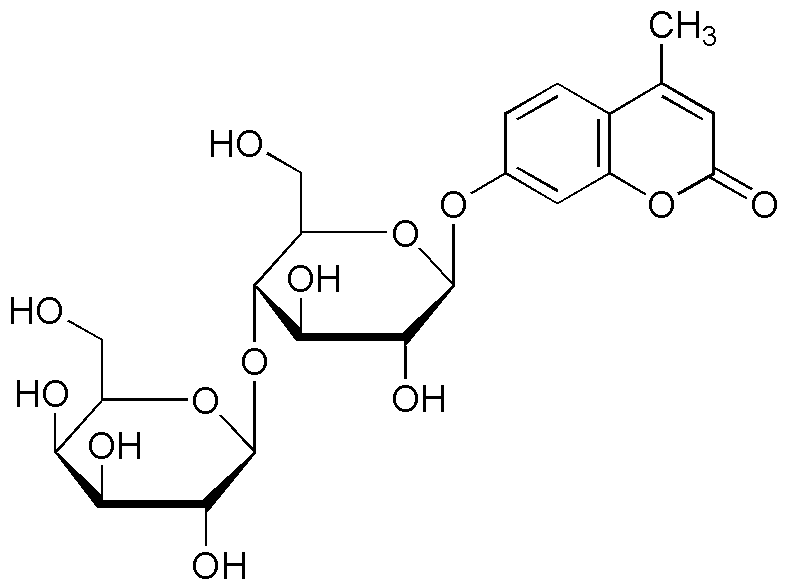4-Methylumbelliferyl-b-D-lactoside is widely utilized in research focused on:
- Enzyme Activity Assays: This compound is commonly used as a substrate in enzyme assays to measure the activity of β-galactosidase. Its fluorescence upon hydrolysis allows for sensitive detection, making it invaluable in biochemical research.
- Microbial Identification: It serves as a selective substrate for identifying specific bacteria, particularly in clinical microbiology. The ability to detect enzyme activity helps in the rapid identification of pathogens.
- Cell Biology Studies: Researchers use this compound to study cellular processes involving glycosylation. Its application in live-cell imaging provides insights into cellular functions and interactions.
- Drug Development: In pharmaceutical research, it aids in screening for compounds that can modulate enzyme activity, which is crucial for developing new therapeutic agents targeting glycosylation-related diseases.
- Food Industry Applications: It is also applied in food science to assess the quality and safety of dairy products by detecting lactose levels, helping ensure compliance with health standards.
Información general
Propiedades
Seguridad y normativas
Aplicaciones
4-Methylumbelliferyl-b-D-lactoside is widely utilized in research focused on:
- Enzyme Activity Assays: This compound is commonly used as a substrate in enzyme assays to measure the activity of β-galactosidase. Its fluorescence upon hydrolysis allows for sensitive detection, making it invaluable in biochemical research.
- Microbial Identification: It serves as a selective substrate for identifying specific bacteria, particularly in clinical microbiology. The ability to detect enzyme activity helps in the rapid identification of pathogens.
- Cell Biology Studies: Researchers use this compound to study cellular processes involving glycosylation. Its application in live-cell imaging provides insights into cellular functions and interactions.
- Drug Development: In pharmaceutical research, it aids in screening for compounds that can modulate enzyme activity, which is crucial for developing new therapeutic agents targeting glycosylation-related diseases.
- Food Industry Applications: It is also applied in food science to assess the quality and safety of dairy products by detecting lactose levels, helping ensure compliance with health standards.
Documentos
Hojas de datos de seguridad (HDS)
La SDS proporciona información de seguridad completa sobre la manipulación, el almacenamiento y la eliminación del producto.
Especificación del producto (PS)
La PS proporciona un desglose completo de las propiedades del producto, incluida la composición química, el estado físico, la pureza y los requisitos de almacenamiento. También detalla los rangos de calidad aceptables y las aplicaciones previstas del producto.
Certificados de análisis (COA)
Busque certificados de análisis (COA) ingresando el número de lote del producto. Los números de lote y de partida se pueden encontrar en la etiqueta de un producto después de las palabras "Lote" o "Lote".
Número de catálogo
Número de lote/lote
Certificados de origen (COO)
Este certificado de origen confirma el país en el que se fabricó el producto y también detalla los materiales y componentes utilizados en él y si se deriva de fuentes naturales, sintéticas u otras fuentes específicas. Este certificado puede ser necesario para cumplir con las normativas aduaneras, comerciales y regulatorias.
Número de catálogo
Número de lote/lote
Hojas de datos de seguridad (HDS)
La SDS proporciona información de seguridad completa sobre la manipulación, el almacenamiento y la eliminación del producto.
DownloadEspecificación del producto (PS)
La PS proporciona un desglose completo de las propiedades del producto, incluida la composición química, el estado físico, la pureza y los requisitos de almacenamiento. También detalla los rangos de calidad aceptables y las aplicaciones previstas del producto.
DownloadCertificados de análisis (COA)
Busque certificados de análisis (COA) ingresando el número de lote del producto. Los números de lote y de partida se pueden encontrar en la etiqueta de un producto después de las palabras "Lote" o "Lote".
Número de catálogo
Número de lote/lote
Certificados de origen (COO)
Este certificado de origen confirma el país en el que se fabricó el producto y también detalla los materiales y componentes utilizados en él y si se deriva de fuentes naturales, sintéticas u otras fuentes específicas. Este certificado puede ser necesario para cumplir con las normativas aduaneras, comerciales y regulatorias.


